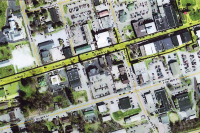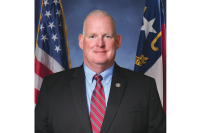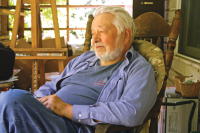The art of stereotyping: Have Southerners gotten a fair shake from pop culture?
 Times may change, but stereotypes tend to linger.
Times may change, but stereotypes tend to linger.
Venturing into the off-color humor and often offensive images of Southern culture portrayed by cartoonists throughout American history, Western Carolina University will address the issue head-on in its newest exhibit opening next week.
“Comic Stripped: A Revealing Look At Southern Stereotypes In Cartoons” will open at the Mountain Heritage Center Feb. 7 and run through mid-May. The traveling showcase was created by the Levine Museum of the New South in Charlotte.
“This provides a fun way to explore a serious subject — how public perception has historically been shaped and continues to be influenced by mass media, how stereotypes can sometimes be true and sometimes misleading,” said Pam Meister, curator at the Mountain Heritage Center. “Visitors will enjoy the wit and humor of this exhibit while coming away with some new insights into their own perceptions of ‘Southern.’”
Cartoon images of the South, for good or ill, have been a mainstay in the pop culture history of this country. The displays ranges from the Thomas Nast drawings for Harper’s Magazine, which shaped American’s perception of the South following the Civil War and during Reconstruction, to Snuffy Smith to Kudzu and the eccentric array of characters in the adult cartoon sitcom “King of the Hill.”
Related Items
“Stereotypes help shape the way we see the South, whether we see it as a land of nature and tradition or the land of moonshine,” said Dr. Tom Hanchett, staff historian and curator of the exhibit at the Levine Museum of the New South in Charlotte. “Whether you grew up with Lil’ Abner and Pogo, or with today’s ‘King of the Hill,’ I think you will be surprised by the power of their Southern images.”
Southerners are chronically painted as simpletons, an image that persisted into modern pop culture with “King of the Hill,” boasting beer swigging men in white undershirts with Southern drawls, often engaged in banal conversations while standing around their trucks or riding mowers.
Meister first came across the exhibit in her previous role as the executive director of the Upcounty History Museum in Greenville, S.C. She was impressed with Hanchett’s work in putting the theme together. It was a popular showcase when it came to Greenville, something Meister knew would transition well to the audience in Western North Carolina.
“One of the things I like best is that it speaks both to native Southerners and to newcomers to our region, and that both adults and children enjoy and relate to it,” she said. “So many visitors recognize old favorites while young visitors enjoy interactive stations that encourage them to explore their ideas about Southern stereotypes.”
The exhibit is comprised of loaned original art and artifacts, including rare vintage comic books and memorabilia. There’s an authentic moonshine jug, a comical hillbilly coat and hat worn in parades by the “Hillbilly Clan” of the Shrine Club, collections of the artwork from Snuffy Smith creator Billy De Beck, and background art and storyboards for an episode of “King of the Hill” that explores youth and religion in the Bible Belt today, amongst other items.
“Exhibits like this illustrate how much we are affected by popular culture,” said Christopher Cooper, professor of political science and public affairs at WCU. “Public opinion isn’t just affected by schools, families, and friends, but also by media, both high brow and low brow. A full understanding of public opinion requires a serious consideration of popular culture.”
Meister is looking forward to seeing how others interact and react to the exhibit. For her, it’s about the younger generation of students, and the public at large, being able to compare and contrast the views they, and others from around the country, have of the South.
“As a native Southerner, who has spent most of my life in the South, but also worked in Los Angeles and Washington, D.C., I can testify that many people still believe traditional stereotypes of Southerners,” she said. “‘Comic Stripped’ uses the larger issues of class, race and cultural heritage in a fun, accessible way, and allows visitors to think about their own perceptions and stereotypes in a series of clever interactive stations located throughout the exhibit.”
Cooper notes that though a lot has been written about the “Southernization of America” or the “Americanization of the South,” there is a general belief that the South is becoming more and more like the rest of the country.
“I’m particularly looking forward to seeing how these stereotypes have changed over time, as I believe that popular culture affects what we believe about a variety of political and social phenomena,” he said.
Cooper said he particularly interested in the political consequences of being perceived as a Southerner. He hopes students go to the exhibit and ask themselves to consider how these depicted stereotypes affect Southern politics and Southern candidates running for national office.
He points to Bill Clinton or Newt Gingrich as prime examples of a “Southern candidate” and how they were viewed in the minds of the country. Cooper asks if certain barriers existed that each could have faced, were there also benefits from being a Southerner, too?
“Southerners still identify with the region in large numbers and the media still tends to portray the South as somewhat distinct from the rest of the country,” Cooper said. “The examples may not be as stark as Snuffy Smith or Andy Griffith, but they do remain and certainly help paint a picture of the South for many in and outside of the region.”
Want to go?
“Comic Stripped: A Revealing Look At Southern Stereotypes In Cartoons” will open Feb. 7 at the Mountain Heritage Center at Western Carolina University in Cullowhee and run through May 14. The center is open 8 a.m. to 5 p.m. Monday through Friday, and until 7 p.m. on Thursday. The exhibit is a free and open to the public. 828.227.7129.









